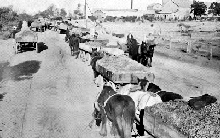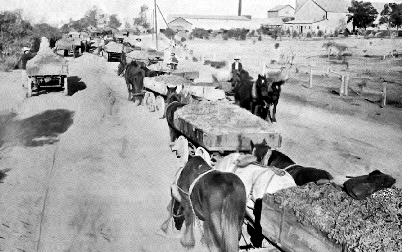| |
|
1927 Vintage Crush 19,968 Tons
Friday March 11th 1927
The enclosing and roofing of Block 3 was in progress and Underground tanks 801 to 812 were being installed and would be covered by a lean-to section. and provision for stillage above the 5,300 gallon tanks would be installed later. Add to this another two 20,000 gallon tanks giving an additional extra storage of 400,000 gallons.
The building in its layout and construction, and the business which it represents, constitute a monument to the genius of the manager. When Mr. Rump, whose experience had been gained at Seppeltsfield, was appointed five years ago, the business was in a bad way and there was a total storage of 35,000 gallons. Today the distillery has a storage capacity of close on 2,000,000 gallons, and there is no sounder business in Australia. The enlargement of the premises has been made possible by generous grants of money from the State Treasury, and the present prosperity is due largely to the Commonwealth export bounty on sweet wine, but Mr. Rump's management must still be counted the prime factor in the success of the venture. Without the assurance of good management, as Mr. Butterfield stated during his recent visit to Berri, the Government might well have hesitated before advancing, as they done, over £100,000 for construction work.
Mr. Rump stated on Friday that some 3,000 tons of Currant grapes had been received this season up to that date. The deliveries were being handled without difficulty, and provision is made for receiving 300 tons of grapes a day, or 1500 tons per week. The management is looking forward to making 500,000 gallons of spirit and 400,000 gallons of sweet wine during the current vintage. This has already been sold at prices that are expected to return the growers a minimum of £8 a ton for their grapes. The total crush should exceed 20,000 tons tons of grapes, and the total wine made (including that for conversion into spirit) should approximate four million gallons.
Speaking subsequently at the luncheon at the Riverside Hotel, Mr. Cheriton said the the distillery has a total storage capacity of 1,950,000 gallons, equal to the product of 13,000 tons of grapes, and bond storage for 138,600 gallons of spirit, the product of 4,000 tons of grapes. The stills were able to treat the wine from 2,400 tons, yielding over 80,000 gallons of spirit a month.
There were 120 fermenting vats with a capacity of 300,000 gallons, 48 for wine maturing with a capacity of 394,000 gallons, and the new room provided storage for 400,000 gallons for distillation. On an estimate of 20,000 tons of grapes the amount paid in Excise this year would be about £255,000. |
 
|
This
photo is from a newspaper cutting from Howard Penrhyn's
records. The scene looking east along the Sturt Highway
shows the waiting loads of grapes and one grower heading
home to continue the harvest. Buildings to the right of
the power pole are the Main Office, No.1 Ferment Cellar
with Boiler Stacks behind, No. 3 Cellar roof with Still
House behind and Tower immediately right and the new building
known as Block3 housing the sixty-six 5,300 and twelve 2,000
gallon underground tanks. |
Friday
April 22nd 1927
Delays
at the Distillery resulting in shareholders waiting six to seven
hours to unload their grapes and the shareholders from the outlying
area of Cobdogla an Loveday felt that a specific crusher could be
allotted for their prime use. Weekly delivery quotas were in force
and there was a general hiccup with the Anzac Day holiday on Monday
which meant that many growers missed out on their weekly delivery.
The writer of the article sincerely hoped that management would
address the problem.
On
the 3rd May 1927 the company became the proprietor of Irrigation
Perpetual Lease 1140, which contained of Sections 445 and 599, and
was signed by:-
J.
Cowan, Minister for Government
J.
C. Cheriton, Chairman
and
Board members as follows:
William A. Lister
F.
H. Nixon
H. McR. Dalziel
Laurice H. Maddern
Norman Dyer
Friday June 24th 1927
A
special general meeting of shareholders was held in the Barmera
Picture Hall on Monday July 4th to discuss the possibility of further
extensions to the plant to increase the daily intake capacity so
the growers' fruit was not hanging on the vines and subject to both
dry and frosty weather. The Board had approached the Adelaide University
requesting advice for controlling the objectionable smell of the
evaporating effluent contained in the "Lily Ponds" and the Winkie
drainage basin. I add the comment that there was never a solution
to this until the company created the existing forest reserve. Need
a photo next trip!! A decision was made to change banking facilities
and the first mortgage was drawn up with the Berri branch of the
State Bank of SA on 28th October 1927. The branch had opened in
1926 and was built on the corner of Wilson Street and Vaughan Terrace.
Tonnage
By Tuesday June 21st 1927, 19,229 tons had passed over the weighbridge.
Friday July 15th 1927
The
Pioneer reported that a meeting of 236 shareholders was held on
the evening of Monday July 4th at Barmera to discuss further extensions
to the distillery. Mr. H. P. Tilley of Messrs G. R. Annells, Tilley
and Henderson (the Company's Auditors) explained in detail the financial
of the Company and shareholders' interest in respect of share capital
should they agree to subscribe the amount required to meet the cost
of further extensions out of their 1927 tonnage delivered. The proposed
extensions would cost approximately £18,000 and would be funded
from share capital and deductions would be 10/- per ton for the
1927 and 1928 vintages. The meeting unanimously agreed for the additions
and alterations to proceed along with deductions from both vintages.
The new vintage cellar became known as No. 2 Ferment Cellar and
was erected at the north east corner of Block 445 and contained
28 open topped tanks each holding 14 tons of must. Configuration
was 4 rows of 7 tanks running east west and the west end 4 tanks
were used as Run-off tanks. Four 6,000 gallon underground tanks
were built at the west end of the building. I am not sure how many
crushers were originally installed, but in 1951 there was a Whitehill
40 ton per hour crusher with 2 grape receival bins. The cellar was
completed in time for the 1928 intake.
Friday
October 28th 1927
I
have taken extracts from the article which was published in the
Murray Pioneer on Friday October 1927 (page 514 on July-Dec 1927
reel at State Library) of a review given by Mr. R. H. Martin, a
committee member of the Federal Viticultural Council, of the operation
of the Wine export Bounty Act at a Viticultural Congress held at
Rutherglen, Victoria. Mr. Martin's address covered the period from
1901 to 1927. In the period 1901-1904 there was an over-production
of grapes and wine and grape prices were reduced to 30/- per ton
which rendered grape growing unprofitable and large areas of vines
were uprooted. During the ensuing years regulations were introduced
which allowed only grape spirit to be used for the fortification
of wine and that which prohibited the making of brandy from anything
other than grape wine. The drought of 1914 was responsible for the
virtual failure of the 1915 vintage and stocks of wine did not become
normal until 1922 when the supply of wine exceeded the demand and
grape prices fell from 1/3rd to 1/2 of the price paid in 1921. In
1923 prices fell further and in 1924 Doradillo's were sold, with
difficulty, as low as £3 per ton.
The
production of wine in Australia for the years 1920 to 1924 gave
a good summary of the industry.
| Vintage |
Gallons |
| 1920 |
7.649,404 |
| 1921 |
11,014,793 |
| 1922 |
8,542,573 |
| 1923 |
11,427,793 |
| 1924 |
14,663,881 |
In
1924 the "Doradillo Committee" estimated that this variety
produced about 9,500,000 gallons which included beverage wine and
wine used for brandy and spirit production plus sweet fortified
wine for export.
Rather than uproot some 10,000 to 15,000 acres, some of which was
still to come into full production, the Federal Viticultural Council
proposed the Bounty Act which came into operation on the 1st September
1924. This provided that a bounty of 4/- per gallon should be paid
on all wines of a merchantable quality and of an alcoholic strength
of no less than 34% proof spirit exported out of Australia. It should
be noted that the excise paid by the winemaker amounts approximately
1/6 per proof gallon, so the so-called bounty of 4/- was actually
made up of a drawback of 1/6 and a bounty of 2/6 per gallon of wine.
British
Tariff rates September 1924
| Wine
Type |
Foreign
Tariff per Gallon |
Empire
Tariff |
| Not Exceeding
42% proof spirit |
Six Shillings |
Five Shillings |
| Not Exceeding
30% proof spirit |
Two and
Sixpence |
One and
Sixpence |
Export Trade Growth for period 1923-1928
| Financial
Period |
Gallons
Exported |
| 1923/24 |
Nil |
| 1924/25 |
875,565 |
| 1925/26 |
1,722,622 |
| 1926/27 |
3,077,588 |
| 1927/28 |
3,152,178 |
The
increase in export to Great Britain reduced stocks of wine and resulted
in a greater demand for grapes and increased prices. Winemakers
responded to this by installing additional storage of both tanks
and casks and the latest machinery to enable the processing of increased
tonnages of grapes.
Prior to this the Prime Minister had directed the Tariff Board to
look at the industry and the Board had recommended to maintain the
bounty at 4/- per gallon for the next 5 years. However a minority
report attached recommended a reduction to 3/- per gallon, and this
was introduced on September 1st 1927 when the 4/- Bounty period
expired on August 31st. This 3/- was made up of a drawback of 1/3d
and a bounty of 1/9d. The other condition was that no wine made
in the 1927 vintage could be exported until September 1st 1927.
When Federal Parliament passed the Bill to amend the Bounty Act
in April 1927 the Minister was also given power set minimum prices
for all grapes and spirit purchased for the manufacture of wine.
This resulted in the winemakers having to pay the equivalent of
2d to 3d per gallon of wine made from grapes purchased by them,
while the selling value of their wine reduced by 1/- per gallon
as per the bounty reduction. These decisions caused severe problems
finance wise and also increased stock levels due the large vintage.
It was summed
up as 15 months of ineptitude and procrastination by the Federal
Parliament!
Bad frost this
year!!!
|
|







